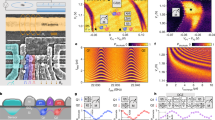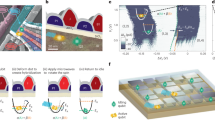Abstract
Spin qubits created from gate-defined silicon metal–oxide–semiconductor quantum dots are a promising architecture for quantum computation. The high single qubit fidelities possible in these systems, combined with quantum error correcting codes, could potentially offer a route to fault-tolerant quantum computing. To achieve fault tolerance, however, gate error rates must be reduced to below a certain threshold and, in general, correlated errors must be removed. Here we show that pulse engineering techniques can be used to reduce the average Clifford gate error rates for silicon quantum dot spin qubits down to 0.043%. This represents a factor of three improvement over state-of-the-art silicon quantum dot devices and extends the randomized benchmarking coherence time to 9.4 ms. By including tomographically complete measurements in our randomized benchmarking, we infer a higher-order feature of the noise called the unitarity, which measures the coherence of noise. This, in turn, allows us to theoretically predict that average gate error rates as low as 0.026% may be achievable with further pulse improvements. These spin qubit fidelities are ultimately limited by incoherent noise, which we attribute to charge noise from the silicon device structure or the environment.
This is a preview of subscription content, access via your institution
Access options
Access Nature and 54 other Nature Portfolio journals
Get Nature+, our best-value online-access subscription
$29.99 / 30 days
cancel any time
Subscribe to this journal
Receive 12 digital issues and online access to articles
$119.00 per year
only $9.92 per issue
Buy this article
- Purchase on Springer Link
- Instant access to full article PDF
Prices may be subject to local taxes which are calculated during checkout





Similar content being viewed by others
Data availability
The data sets generated during and/or analysed during the current study are available from the corresponding authors on reasonable request.
Code availability
The analysis code that support the findings during the current study are available from the corresponding authors on reasonable request.
References
Knill, E. Quantum computing with realistically noisy devices. Nature 434, 39–44 (2005).
Fowler, A. G., Mariantoni, M., Martinis, J. M. & Cleland, A. N. Surface codes: towards practical large-scale quantum computation. Phys. Rev. A 86, 032324 (2012).
Veldhorst, M. et al. An addressable quantum dot qubit with fault-tolerant control-fidelity. Nat. Nanotechnol. 9, 981–985 (2014).
Kawakami, E. et al. Gate fidelity and coherence of an electron spin in an Si/SiGe quantum dot with micromagnet. Proc. Natl Acad. Sci. USA 113, 11738–11743 (2016).
Watson, T. F. et al. A programmable two-qubit quantum processor in silicon. Nature 555, 633–637 (2018).
Zajac, D. M. et al. Resonantly driven CNOT gate for electron spins. Science 359, 439–442 (2017).
Yoneda, J. et al. A quantum-dot spin qubit with coherence limited by charge noise and fidelity higher than 99.9%. Nat. Nanotechnol. 13, 102–106 (2017).
Emerson, J., Alicki, R. & Życzkowski, K. Scalable noise estimation with random unitary operators. J. Opt. B 7, S347–S352 (2005).
Knill, E. et al. Randomized benchmarking of quantum gates. Phys. Rev. A 77, 012307 (2008).
Dankert, C., Cleve, R., Emerson, J. & Livine, E. Exact and approximate unitary 2-designs and their application to fidelity estimation. Phys. Rev. A 80, 012304 (2009).
Magesan, E., Gambetta, J. M. & Emerson, J. Scalable and robust randomized benchmarking of quantum processes. Phys. Rev. Lett. 106, 180504 (2011).
Magesan, E., Gambetta, J. M. & Emerson, J. Characterizing quantum gates via randomized benchmarking. Phys. Rev. A 85, 042311 (2012).
Wallman, J. J. Randomized benchmarking with gate-dependent noise. Quantum 2, 47 (2018).
Wallman, J. J., Granade, C., Harper, R. & Flammia, S. T. Estimating the coherence of noise. New J. Phys. 17, 113020 (2015).
Kimmel, S., da Silva, M. P., Ryan, Ca, Johnson, B. R. & Ohki, T. Robust extraction of tomographic information via randomized benchmarking. Phys. Rev. X 4, 011050 (2014).
Feng, G. et al. Estimating the coherence of noise in quantum control of a solid-state qubit. Phys. Rev. Lett. 117, 260501 (2016).
Fogarty, M. A. et al. Nonexponential fidelity decay in randomized benchmarking with low-frequency noise. Phys. Rev. A 92, 022326 (2015).
Khaneja, N., Reiss, T., Kehlet, C., Schulte-Herbrüggen, T. & Glaser, S. J. Optimal control of coupled spin dynamics: design of NMR pulse sequences by gradient ascent algorithms. J. Magn. Reson. 172, 296–305 (2005).
Huang, W. et al. Fidelity benchmarks for two-qubit gates in silicon. Nature (in the press); preprint available at https://arxiv.org/abs/1805.05027
Muhonen, J. T. et al. Quantifying the quantum gate fidelity of single-atom spin qubits in silicon by randomized benchmarking. J. Phys. Condens. Matter 27, 154205 (2015).
Wallman, J. J. Bounding experimental quantum error rates relative to fault-tolerant thresholds. Preprint at https://arxiv.org/abs/1511.00727 (2015).
Kueng, R., Long, D. M., Doherty, A. C. & Flammia, S. T. Comparing experiments to the fault-tolerance threshold. Phys. Rev. Lett. 117, 170502 (2016).
Dugas, A. C., Wallman, J. J. & Emerson, J. Efficiently characterizing the total error in quantum circuits. Preprint at https://arxiv.org/abs/1610.05296v1 (2018).
Barends, R. et al. Superconducting quantum circuits at the surface code threshold for fault tolerance. Nature 508, 500–503 (2014).
Ballance, C. J., Harty, T. P., Linke, N. M., Sepiol, M. A. & Lucas, D. M. High-fidelity quantum logic gates using trapped-ion hyperfine qubits. Phys. Rev. Lett. 117, 060504 (2016).
Rong, X. et al. Experimental fault-tolerant universal quantum gates with solid-state spins under ambient conditions. Nat. Commun. 6, 8748 (2015).
Chan, K. W. et al. Assessment of a silicon quantum dot spin qubit environment via noise spectroscopy. Phys. Rev. Appl. 10, 044017 (2018).
Itoh, K. M. & Watanabe, H. Isotope engineering of silicon and diamond for quantum computing and sensing applications. MRS Commun. 4, 143–157 (2014).
Angus, S. J., Ferguson, A. J., Dzurak, A. S. & Clark, R. G. Gate-defined quantum dots in intrinsic silicon. Nano Lett. 7, 2051–2055 (2007).
Lim, W. H. et al. Observation of the single-electron regime in a highly tunable silicon quantum dot. Appl. Phys. Lett. 95, 242102 (2009).
Granade, C., Ferrie, C. & Cory, D. G. Accelerated randomized benchmarking. New J. Phys. 17, 013042 (2015).
Granade, C. et al. QInfer: statistical inference software for quantum applications. Quantum 1, 5 (2017).
Ball, H., Stace, T. M., Flammia, S. T. & Biercuk, M. J. Effect of noise correlations on randomize benchmarking. Phys. Rev. A 93, 022303 (2016).
Magesan, E. et al. Efficient measurement of quantum gate error by interleaved randomized benchmarking. Phys. Rev. Lett. 109, 080505 (2012).
Acknowledgements
The authors acknowledge support from the US Army Research Office (W911NF-13-1-0024, W911NF-14-1-0098, W911NF-14-1-0103 and W911NF-17-1-0198), the Australian Research Council (CE170100009 and CE170100012) and the NSW Node of the Australian National Fabrication Facility. B.H. acknowledges support from the Netherlands Organization for Scientific Research (NWO) through a Rubicon Grant. K.M.I. acknowledges support from a Grant-in-Aid for Scientific Research by MEXT, NanoQuine, FIRST and the JSPS Core-to-Core Program. The views and conclusions contained in this document are those of the authors and should not be interpreted as representing the official policies, either expressed or implied, of the Army Research Office or the US Government.
Author information
Authors and Affiliations
Contributions
C.H.Y. conceived and designed the GRAPE pulse sequences and the feedback control systems for the experiments. C.H.Y. and K.W.C. performed the experiments. C.H.Y., R.H., T.E., S.T.F. and S.D.B. analysed the data. K.W.C. and F.E.H. fabricated the device. K.M.I. prepared and supplied the 28Si epilayer wafer. All authors contributed materials, analysis and/or tools. C.H.Y., R.H., S.T.F., S.D.B. and A.S.D. wrote the paper with input from all co-authors. A.S.D. supervised the project.
Corresponding authors
Ethics declarations
Competing interests
The authors declare no competing interests.
Additional information
Publisher’s note: Springer Nature remains neutral with regard to jurisdictional claims in published maps and institutional affiliations.
Supplementary information
Supplementary Information
Supplementary Figs. 1–2, Supplementary equations 1–2, Supplementary Table 1
Rights and permissions
About this article
Cite this article
Yang, C.H., Chan, K.W., Harper, R. et al. Silicon qubit fidelities approaching incoherent noise limits via pulse engineering. Nat Electron 2, 151–158 (2019). https://doi.org/10.1038/s41928-019-0234-1
Received:
Accepted:
Published:
Issue Date:
DOI: https://doi.org/10.1038/s41928-019-0234-1
This article is cited by
-
Hamiltonian phase error in resonantly driven CNOT gate above the fault-tolerant threshold
npj Quantum Information (2024)
-
Pipeline quantum processor architecture for silicon spin qubits
npj Quantum Information (2024)
-
Rapid single-shot parity spin readout in a silicon double quantum dot with fidelity exceeding 99%
npj Quantum Information (2024)
-
Non-symmetric Pauli spin blockade in a silicon double quantum dot
npj Quantum Information (2024)
-
Modeling Si/SiGe quantum dot variability induced by interface disorder reconstructed from multiperspective microscopy
npj Quantum Information (2024)



